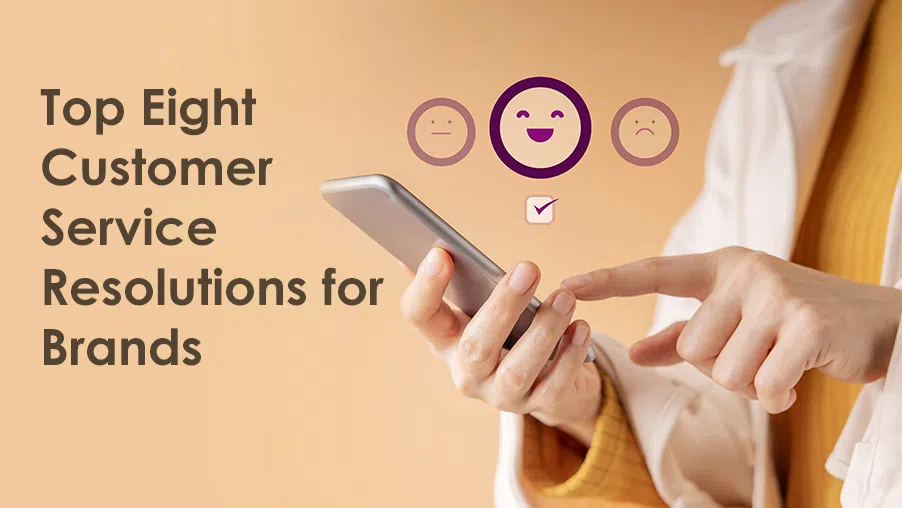Top Eight Customer Service Resolutions for Brands
- Peak Support

Top Eight Customer Service Resolutions for Brands
Year after year, there are a lot of disappointing customer experiences, and with them come a lot of excuses.
When are companies going to finally drop the excuses and start making the badly needed changes? If money is the issue, isn’t there more to be lost from unhappy customers choosing to stop doing business with a company, than there is in investing in ways to provide better customer service experiences?
When customers are happy, they tend to buy more from the company. They’ll even give companies free exposure through word of mouth to their friends and family, as well as provide positive reviews online.
Zendesk asked customers what factor impacts their level of trust with a company, and providing excellent customer service ranked the highest.
It’s another year, and with that comes opportunities for companies to improve their customer service. Companies need to stop justifying or worse, defending their mediocre customer service offering. Those that want to, will find ways. Those that don’t? Will come up with excuses.
Here are the top 8 customer service resolutions that companies should strive hard to do and achieve:
Cut your wait time.
If you’re notorious for your long queues, or long wait times for email and chat responses, then explore various options on how to cut your response time or wait time in half. If that’s too aggressive, try cutting it by 10%. From there, you can work your way up every month until you achieve your goal. If you can’t do it on your own, consider bringing on a business process outsourcing partner to help. But you must make sure that you find the right business process outsourcing partner that’s going to meet all your needs.
Review your customers’ biggest complaints.
After all, 52% of consumers worldwide want companies to act on the feedback they’ve been given. Nothing is more insulting to customers than when companies continue to make the same mistakes – because it means that they’re not listening. Ask team leads or the QA team to compile a weekly list of customer complaints, go over them, and apply the necessary changes to make sure that these issues never come up again. If you can’t commit to doing this every week, start by doing it once – I promise it’ll be enlightening. Another idea: Read the CSAT reviews that you get for a month. Typically, the most satisfied and most dissatisfied leave comments – you’ll get valuable insights from both.
Don’t just listen to your customers – understand what they’re saying.
Empathizing with the customer is better than sympathizing with them. Educate your reps on the difference between the two.
Use your data.
Are you using all the data available to you? Your helpdesk data could help you understand queuing trends, staffing problems, poor agent performances, and other important product and/or service issues. Commit to looking at your current reporting and identifying at least one way to improve it.
And if you’re not collecting any Key Performance Indicators (KPIs)…pick one and start! Check out our eBook on KPIs for customer service if you’re trying to find the right place to start.
Get on the queue.
Read a handful of tickets or listen to at least one phone call every week, even if it’s not your job. Study those calls. Make sure to ask your agents important questions such as what was the customer’s problem; were they more frustrated about the product/service or the process of reporting the issue; what could’ve been done to make the experience more delightful and efficient? Once you have the answers you need, come up with solutions on how you can consistently provide better customer experiences.
Review your training.
Are you training your agents enough before putting them on the queue? Once they’re on the queue, are they getting enough coaching and refresher training? As a first step, ask your agents whether they are being adequately trained, then commit to improving your training if necessary.
Chat is the new phone call.
Customers prefer it over other communication channels for the immediacy it offers. But it’s important to remember one thing: don’t eat up your customers’ patience with those unhelpful bots. Instead, offer longer availability for human chat representatives. If you don’t want to or can’t afford to hire real humans to chat with your customers for 24 hours, then do eight hours. You’re at the liberty to adjust the live chat availability (with a human) depending on your company’s need. Chatting with a bot, no matter human-sounding they may seem, just isn’t that enjoyable. Here’s a complete guide on how you can implement live chat.
Enough with the worn-out opening spiels.
By now, most of your customers have probably already memorized what your agents are going to say once they answer the call. Instead of the usual “Thank you for calling, x company. How can I help you today?” Get creative! Make it fun and exciting, and maybe even add a personal touch. The last thing any customer, who’s been waiting on queue for at least 2-5 minutes, wants to hear is an archaic and uninspiring opening greeting from your agents. Ask your communications trainers for advice on how to go about it. You can also encourage your agents to improvise, but don’t forget to remind them of their limits and responsibilities. Fun and relatable doesn’t have to mean unprofessional.
